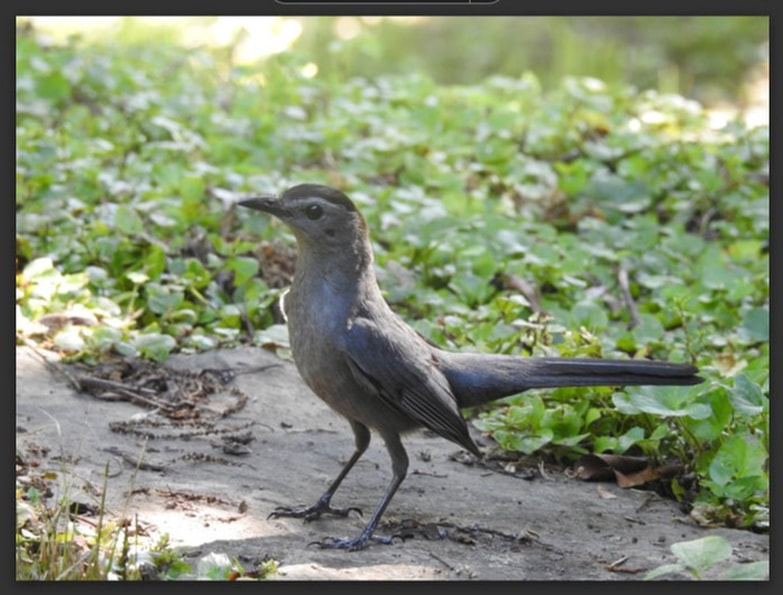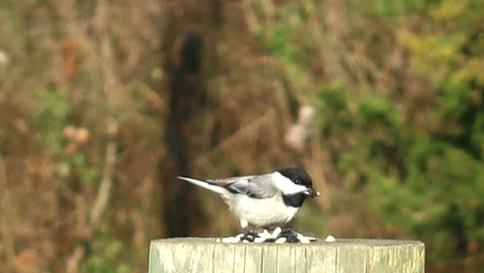 Gray catbird; Credit: Deanne Lawrence Gray catbird; Credit: Deanne Lawrence Sycamore Grove Farm, Madison County The gray catbird (Dumetella carolinenesis) is a migratory bird in our area, returning to Virginia by the last week in April and leaving in large numbers for more tropical climates in the last week of September and early October. While breeding, the catbird protects its young. During nesting season, it is very territorial. It will chase away other songbirds, sometimes even destroying their nests. So it’s no surprise that it doesn’t tolerate the brown-headed cowbird. There are 247 species of birds that end up caring for cowbird’s eggs and nestlings – but not the catbird! Catbirds are among the small number of birds (including blue jays, American robins and brown thrashers) that deftly reject cowbird eggs. If a cowbird introduces an egg into its nest, the catbird quickly breaks the egg and tosses it out. Catbirds inhabit a wide variety of shrubby habitats, including suburban backyards. The male singing in your backyard during mating season is likely to be the one that was there last year. Studies have found that a catbird returns to the previous year's nesting location place throughout its life. While its average life span is 2 ½ years, only about 60% of catbirds survive each year. The longest living catbird recorded was 17 years and 11 months old. The gray catbird’s voice is a reflection of this songster. A relative of the mockingbird, it copies the sounds of other species in its habitat. It is best known for the cat-like mewing calls from which its common name comes. I have heard stories of people who called the local animal control office, concerned about a cat in their backyard. But it turned out to be a catbird (how embarrassing was that!). We have several catbirds on our farm. I am fascinated to watch them sit on fence posts, jerking their long tails back and forth. Primarily ground-feeders, they flip leaves and other debris aside to find insects, including beetles, ants, caterpillars and grasshoppers. Catbirds also eat spiders, millipedes and wild berries. They are known to be “junk food” eaters, as well. Catbirds have been observed eating doughnuts, cheese, boiled potatoes and corn flakes! Their habit of pecking fruit (but not totally eating it) can make them unpopular with gardeners. But it’s worth a few piece of fruit to have this delightful bird be part of the birds around you. Happy birding! Charlene
0 Comments
Sycamore Grove Farm, Madison County I have always found the “roadside silhouettes” on the inside cover of Peterson’s "A Field Guide to the Birds East of the Rockies" to be an excellent bird identification tool. Even if the only thing you can see is the bird’s silhouette, it can narrow your choices very quickly. So I found it interesting that Roger Tory Peterson selected the mourning dove (Zenaida macroura) for that position.
If you have ever heard a mourning dove, you can understand where its common name comes from - the mournful cooing made by both males and females. Its distinctive head bobbing as it walks is another clue to identifying this bird. Doves feed on the ground, swallowing seeds and storing them in an enlargement of their esophagus called the crop. Once the crop is full, a dove will fly to a perch to digest its meal. The record for ingested seeds is 17,200 bluegrass seeds in a single bird’s crop! Mourning doves are monogamous and often mate for life. They are known for making flimsy platform nests of twigs that often fall apart in a storm. The female usually lays two eggs and incubation takes just two weeks. Both adults feed their chicks crop-milk, which is regurgitated liquid that has been stored in the adult’s crop. This nutrient-rich liquid is used to nourish squabs (the name for young doves and pigeons). The mourning dove lives about two years and is one of our most common birds. It is usually found in open countryside and frequently seen roosting on telephone and electric lines. The only place you won’t see it is in deep woods. When it takes take off in flight, its wings make a distinctive whistling or whinnying noise. The oldest known mourning dove was at over 30 years old who it was shot in Florida in 1998. It had been banded in Georgia in 1968. The mourning dove is the most widespread and abundant game bird in North America. While every year hunters harvest more than 20 million, its population is actually increasing and is estimated to be around 350 million. Happy birding! Charlene Sycamore Grove Farm, Madison County You have probably heard the Carolina chickadee’s song – “chickadee-dee-dee” – if you have a birdfeeder or trees in your yard or you have woods near your home. We have two pairs that consistently enjoy the food I put out for the birds on fence posts separating our farm from the neighboring farm to the west.  Carolina chickadee; Credit: Charlene Uhl Carolina chickadee; Credit: Charlene Uhl The Carolina Chickadee (Poecile carolinensis), which is in the same family as the Tufted Titmouse (Paridae), is widespread in Virginia and the most common chickadee in the state. Their preferred habitats include mixed and deciduous woods, river groves, shade trees and well-wooded suburbs. Chickadees are one of the first birds to use a newly placed bird feeder. They visit for sunflower seeds, peanut chips and suet. The chickadee will fly to the feeder, grab a single seed, carry it to a branch and hold the seed down with its feet. It hammers the shell open to get the meat inside. It then quickly returns to the feeder to get another seed. Their diet is mostly insects and spiders but they also eat seeds and berries, especially in the winter. Their acrobatic feeding habits are a delight to watch: they hang upside down and tilt their head and body up to reach insects on leaves and under tree bark. They sometimes take food while hovering and may fly out to catch insects in mid-air. Chickadees can be attracted to your property by offering a nest box or nest tube with a 1-1/4 inch entrance opening. Despite their small size, they are relatively fearless and are one of the species of birds that will commonly try to drive away predators such as hawks, owls and snakes. Like the titmouse, however, they are very vulnerable to predation by outdoor cats. The Carolina chickadee was among the birds named by John James Audubon when he was in South Carolina. The black-capped chickadee (Poecile atricapillus)) is very similar in appearance but less seen in our state. Where the two species’ range come into contact, the Carolina chickadee and the black-capped chickadee will occasionally hybridize. Hybrids can sing the songs of either species and might sing something that is a blend of the two songs. A chickadee pair bond between a male and female can last for several years. During the winter chickadees band together in large flocks. The life span of a Carolina chickadee is 2-3 years. The longest-lived known was 10 years 11 months old and found in West Virginia in 1974. Bluebird update: We have a pair of bluebirds that have built a nest in our second nest box – and this morning I counted 4 beautiful blue eggs. It is such a joy to offer a “home” for a bluebird family on our farm each year! Happy birding! Charlene |
Have a blog or blog idea?
Let us know (click) Other Blogs
VA Native Plant Society - click Brenda Clement Jones - click John Muir Laws' Blog - click Megan's Nature Nook - click Categories
All
Archives
September 2023
Blog Administrator:
Kathleen A. VMN since 2018 |
